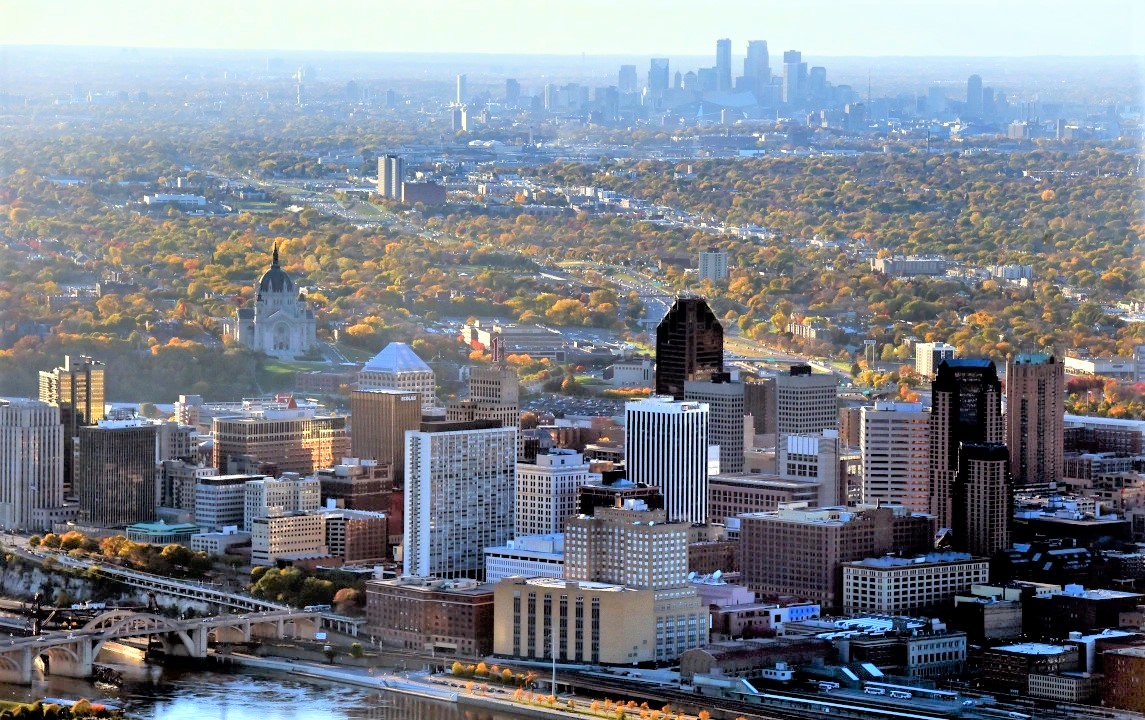
St. Paul Downtown Alliance seeks to double in size, hire a prosecutor for quality-of-life crimes
In St. Paul, organizers of a Downtown Improvement District have officially petitioned the city to heavily expand its existing geography, doubling the district’s size to encompass all of downtown while adding residential properties such as condominiums and apartment buildings.
If approved by the city council next month, the new district will allow the St. Paul Downtown Alliance to assess property owners an annual fee for bike patrols, litter and graffiti removal, street greeters and skyway ambassadors, among other organized activities.
Public safety measures loom increasingly large as priorities. The district’s governance board even hopes to help the city hire a prosecutor.
Next year, the St. Paul Downtown Alliance will officially ask the city to add an additional city attorney exclusively dedicated to pursuing perpetrators of non-felony, quality-of-life issues downtown, especially chronic offenders. If private funds are used to fund the new attorney, which remains to be seen, it would be a departure from the norm for City Hall, but not unprecedented nationally.
A model from other cities
Backed in part by local businesses, Portland, Ore., began experimenting in the 1990s with “neighborhood prosecutors” to address local nuisances, from theft to illegal encampments. The Neighborhood Prosecution Unit is still active today, housed within the Multnomah County District Attorney’s Office.
“We’ve seen that model work in other cities,” said Joe Spencer, president of the Downtown Alliance. “Milwaukee has had a lot of success with the district paying for and having a prosecutor dedicated through the district. The notion is you have an extra resource to help support police officers downtown if there are repeat offenders, or someone causing a lot of damage. We’ve had positive initial conversations with the mayor’s office and with council members, but there’s still a lot of details to be worked out.”
City Attorney Lyndsey Olson sounded a skeptical tone on Thursday.
“At the core of our democracy and Constitutional protections is the independence of our judicial system,” said Olson, in a written statement Thursday evening. “Prosecutors cannot be hired by private interests nor paid to prosecute specific cases or individuals. The St. Paul City Attorney’s office is committed to upholding the integrity of the rule of law and seeking just outcomes for every case presented to us. We are deeply engaged in partnering with law enforcement, justice partners and community to realize safe outcomes across our city.”
Even without a new prosecutor, Downtown Alliance members say that since the launch of St. Paul’s Downtown Improvement District in 2021, quality-of-life calls to police fell by 40% within the district’s boundaries, even as they increased in other parts of downtown.
“We feel confident we can deliver good value and make some improvements downtown,” Spencer said.
The existing district spans some 30 blocks in and around Rice Park, with an odd panhandle that extends toward Lowertown but stops several blocks short of Mears Park. The new district would encompass all of downtown, from the Xcel Energy Center to CHS Field, and from the Mississippi River to Interstate 94.
At a time when remote work and shifting demographics have taken their toll on downtown properties still rebuilding from the pandemic, the effort has drawn supporters and critics.
The St. Paul Downtown Alliance has petitioned the city to double the size of an existing Downtown Improvement District to span all of downtown, including Lowertown. The existing district is depicted in red and the proposed new area in blue. Property owners — including owners of apartment buildings and individual condominiums — would be assessed an annual fee, averaging about $65 per condo. (Courtesy of the Downtown Alliance)
Annual fees
Olaf Minge, a retired information technology manager who moved to Lowertown from Edina last September with his wife, used to pick up litter downtown for a couple of hours daily within an eight-block loop. After three months, he said, he felt overwhelmed.
“In Edina, there’s not a blade of grass out of place without everybody hovering around trying to fix it,” said Minge, who is rooting for the Downtown Improvement District’s expansion. “In St. Paul, we have such an amazing city with things to do — the Saints stadium, the Xcel Center, the farmers’ market, the library — but there’s trash.
“Most people expect the city to take care of this kind of a thing, but their Public Works Department isn’t staffed to pick up litter, and the police aren’t staffed to check in on every person on the street,” he added. “If there’s somebody doing graffiti, it doesn’t rise to the same level as human trafficking or gun violence.”
If the district expands as planned, its annual budget would grow from $1.3 million to about $2.68 million. St. Paul and Ramsey County currently pay in $300,000, which would increase to $675,000. The rest is covered by the private sector.
Bill Hanley, a Lowertown condo owner, said he had been skeptical of the expansion effort until he learned his annual assessment — which is based in part on square footage — would be $75, or less than half of initial projections.
The average for condo owners will be closer to $65, Spencer said.
For commercial properties, the annual assessment would add up to about 6.4 cents per square foot of gross building area, plus $13.61 per foot of linear street frontage. For residential properties, it would be 3.8 cents per square foot, plus $8.17 per linear foot of street frontage, with prorating for condominiums.
Individual owners of apartment buildings will have to decide whether to add that fee to their tenants’ monthly leases or simply swallow the cost.
Property owners
The 11-member governance board is currently chaired by Clint Blaiser, who is both a downtown resident and developer, with Zach Atherton-Ely, an executive with Mille Lacs Corporate Ventures and the InterContinental and DoubleTree hotels, serving as vice chair. “People are for it,” Blaiser said. “I haven’t talked to every single apartment building owner, but I’ve talked to a number of them. It’s been successful on the other side of downtown. People are happy with it.”
The Kaeding Development Group, which owns both commercial and residential property downtown, also signaled its support in a written statement, as have founding members such as Securian Financial.
“There’s clearly a level of support and interest in expanding this district in ways that are probably significant,” said Hanley, 70, a former news director with Twin Cities Public Television, which is based downtown, who is active on skyway governance issues. “There’s really no reason not to try it.”
Still, Bigos Management, which owns several residential buildings in Lowertown, has yet to publicly commit. Efforts to include West Seventh Street businesses in an expanded downtown district fell flat a year ago when a series of bar and restaurant owners objected to being charged fees for services they felt should already be covered by their property taxes.
By state statute, expanding the Downtown Improvement District requires the consent — an active petition — from 25% of property owners within the new boundaries. Even if the newly expanded district is approved by the city council, a petition from 35% percent of property owners could override the council decision.
A changing downtown
Prior to its launch in 2021, St. Paul was the only one of the largest 65 cities in the country that did not have a downtown improvement district.
When the St. Paul Downtown Alliance launched the district, it took care to avoid most of the commercial properties owned by Madison Equities, the real estate firm led at the time by the sometimes litigious James Crockarell.
The result was what even some supporters have described as a gerrymandered map that spans roughly half the area commonly thought of as downtown St. Paul, with a panhandle that juts out to Jackson Street and Seventh Place while excluding Mears Park and much of Lowertown.
Crockarell died in January and most of Madison Equities’ downtown holdings have since been put up for sale. The state Legislature last year altered the law governing improvement districts to allow residential and multi-family properties to participate, opening the door for all of downtown to be incorporated, including condominiums and apartment buildings rather than just commercial and industrial structures.
Questions remain
Plenty of questions remain, including whether board governance of the Downtown Improvement District will expand to include residential tenants and condo owners, and if so, to what degree. “If this goes through, they would look to probably add board seats and add board members, the goal being to be representative of the stakeholders paying into the district,” Spencer said.
Despite his support for the expanded improvement district, Hanley, a former chair of the Skyway Governance Advisory Committee, still feels the Downtown Alliance needs to do more to elevate all residents’ perspectives.
Downtown St. Paul is home to about 10,000 residents, but St. Paul Mayor Melvin Carter’s administration and the Downtown Alliance have set their sights on increasing the downtown population to 30,000 residents. Even an issue as seemingly mundane as non-service dogs traveling through the skyway — which are currently banned, but still proliferating — may require rethinking city ordinances and management approaches, Hanley said.
“There’s clearly going to be some changes. I just think there’s going to be a lot of interesting things that have to be navigated, if you’re going to put 30,000 people here,” Hanley said. “The character of a space like downtown changing that way, how does it all work?”
More information about the Downtown Improvement District is online at spdid.org.
Related Articles
Chris Duffy: A newspaper’s longevity should be acknowledged, celebrated
Lake Elmo Inn owners to open new restaurant within downtown St. Paul’s Union Depot
Sturgill Simpson to play first Twin Cities show in eight years at Roy Wilkins Auditorium
Fairview, Acadia celebrate construction of 144-bed mental health hospital in St. Paul
After a rough 2023, St. Paul’s Park Square Theatre announces 2024/25 season


